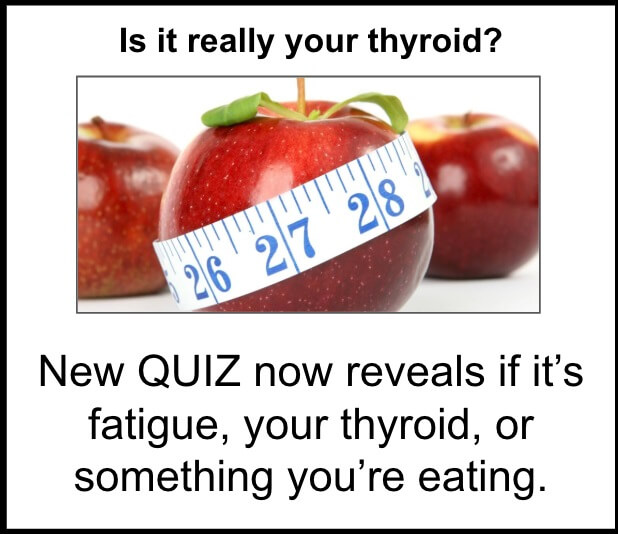1) Grab a FREE copy (Value $14.95) of one of my books Thyroid Symptom Overload
Just pay shipping $7.95 for any US orders. Or, if you want to pay full price plus shipping, order from Amazon :)
2) Take our Thyroid Quiz today and find out what "Thyroid Type" you have
This quiz will help you quickly discover where your symptoms are stemming from.
3) Join Our Thyroid Advocate Membership Site - Natural Thyroid Academy
FREE for a limited time. No credit card required.
4) Work with me and my team privately
Schedule your FREE 15 minute phone consultation and we can find out the best way to help you specifically.
Thyroiditis is inflammation of the thyroid gland. There are many different kinds of problems that can occur with the thyroid gland, but inflammation is the most common. But when the inflammation increases, it needs to be taken seriously.
Do you think you or one of your loved ones may be suffering from some kind of thyroid condition? Want to find out what thyroiditis is? What its different forms are? Here are all the answers for you.
Understanding Thyroiditis and It’s Types
Thyroiditis, as mentioned before, is the inflammation of the thyroid gland. But this is the umbrella term and it is further divided into more specific types of thyroiditis, which can then become further aggravated if they are not treated in time.
The most common type of thyroiditis in US is Hashimoto’s thyroiditis which is also believed to be the leading factor of hypothyroidism. Here are all the different types of thyroiditis that can occur.
Hashimoto’s Thyroiditis
The most common kind of thyroid disease in US is Hashimoto’s thyroiditis. It is an autoimmune condition, meaning a disease where the immune system starts malfunctioning and attacks the thyroid gland. Hashimoto’s is also said to be the most common reason why people later develop hypothyroidism. It is also known as chronic lymphocytic thyroiditis.
Some of the most common signs and symptoms of Hashimoto’s are:
- Dry skin and brittle hair
- Depression
- Constipation
- Feeling cold
- Swelling in the eye and legs
- Weight gain or difficulty losing weight
- Heart failure
- Low body temperature
- Coma
- Lowered heart rate
- Heart failure
Hypothyroidism that occurs because of Hashimoto’s disease cannot be cured and is there for life due to its genetic makeup. However, the symptoms can be managed effectively and the patient can lead a healthy, normal life if the condition is diagnosed in time.
Postpartum Thyroiditis
Postpartum thyroiditis, as the name implies, takes place after the birth of a baby. It is a temporary condition and usually occurs 1-4 months after the baby is born. There are two phases of the disease where the first phase is quite similar to thyrotoxicosis and can be from 1-4 months after birth. The second phase of postpartum thyroiditis can be anywhere from 4-8 months of birth and symptoms are like those of hypothyroidism.
For most women, the disease usually ends within a year or 18 months from birth of their babies. There are also many women who don’t even go through phase two of the postpartum thyroiditis. There are also about 20% women who experience permanent hypothyroidism because of postpartum thyroiditis. Studies show that this happens to women whose thyroiditis is because of autoimmune disease or because of the presence of anti-thyroid antibodies.
Common signs and symptoms of postpartum thyroiditis include:
- Palpitations
- Cold intolerance
- Constipation
- Dry skin and brittle hair
- Fatigue
- Weight gain
Acute Thyroiditis
Acute thyroiditis is one of the only kinds of thyroid problems that goes away on its own. It takes place due to the presence of some kind of bacteria or infectious organism that finds its way in the body. When the patient contracts the disease, they become violently ill. The thyroid also becomes very painful.
Instead of treating the symptoms of the condition itself, most medical doctors target the infection. Once the infection is cured, the condition starts getting better. Acute thyroiditis vanishes the instant the infection gets cleared up.
DeQuervain’s Thyroiditis
DeQuervain’s Thyroiditis is not as common as Hashimoto’s thyroiditis. It firms up the thyroid gland and makes it large. The gland not only becomes tender but also painful to the touch. Initially, there is excessive production of the thyroid hormone leading to hyperthyroidism. But within a short period of time, the lack of iodine in the body leads to shortage of thyroid hormone.
Many experts believe that the main reason for the occurrence of DeQuervain’s thyroiditis is some kind of viral infection. It is also referred to as subacute thyroiditis or granulomatous thyroiditis. Some common signs and symptoms include:
- Pain in the jaw, ear and neck
- Firm and enlarged thyroid
- Fever
- Exhaustion and weakness
It may sound like a very serious disease, but the truth is that DeQuervain’s thyroiditis is not a very dangerous condition. It is not permanent and once it is diagnosed, the only thing it is treated with is bed rest and aspirin. The thyroid goes back to working normally in no more than a year to 18 months. There are very few times that patients develop permanent cases of hypothyroidism because of granulomatous thyroiditis.
Silent Thyroiditis
This is the least common type of thyroiditis. It was discovered well after the 1970’s and is somewhat a mix of Hashimoto’s and DeQuervain’s thyroiditis. Most people don’t even need to have the condition treated because the symptoms get better on their own over a short period of time. Some common signs and symptoms include:
- Palpitations
- Mild hypothyroidism
- Slight enlargement of thyroid gland
Most of the patients are advised bed rest for the symptoms. Some are also given beta blockers for their palpitations. Only 20% of the patients develop permanent hypothyroidism.
Drug Induced Thyroiditis
The use of certain medication or radiation can also cause thyroiditis. It is usually discovered when thyroid function tests are performed and it can in most cases lead to permanent hypothyroidism. Signs and symptoms include an enlarged thyroid gland or some slight signs of hypothyroidism. For most patients who get thyroiditis, different modes of treatment are suggested depending on how they got the condition in the first place or how severe the situation may be.
References
- https://www.thyroid.org/thyroiditis/
- https://www.endocrineweb.com/conditions/thyroid/thyroiditis
- http://www.jorl.net/otolaryngology/hasimotos-thyroiditis-a-review.pdf








